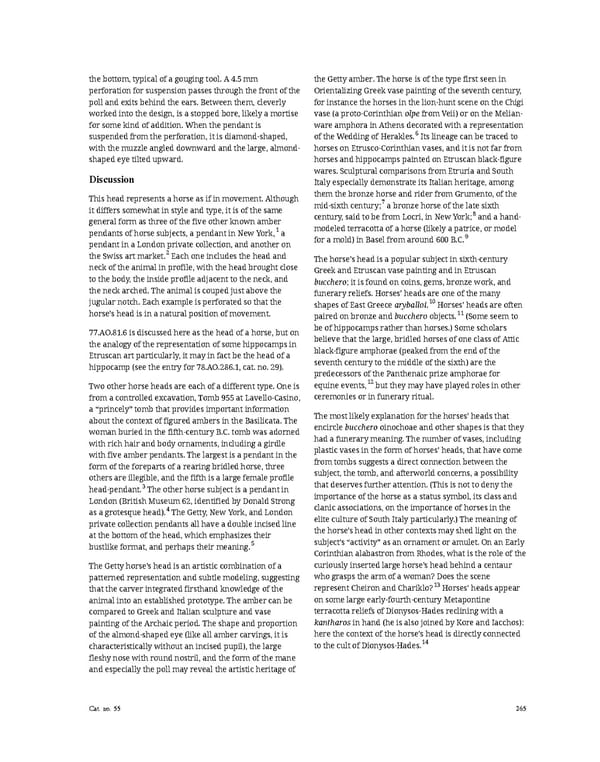the bottom, typical of a gouging tool. A 4.5 mm the Getty amber. The horse is of the type first seen in perforation for suspension passes through the front of the Orientalizing Greek vase painting of the seventh century, poll and exits behind the ears. Between them, cleverly for instance the horses in the lion-hunt scene on the Chigi worked into the design, is a stopped bore, likely a mortise vase (a proto-Corinthian olpe from Veii) or on the Melian- for some kind of addition. When the pendant is ware amphora in Athens decorated with a representation suspended from the perforation, it is diamond-shaped, of the Wedding of Herakles.6 Its lineage can be traced to with the muzzle angled downward and the large, almond- horses on Etrusco-Corinthian vases, and it is not far from shaped eye tilted upward. horses and hippocamps painted on Etruscan black-figure Discussion wares. Sculptural comparisons from Etruria and South Italy especially demonstrate its Italian heritage, among This head represents a horse as if in movement. Although them the bronze horse and rider from Grumento, of the mid-sixth century;7 a bronze horse of the late sixth it differs somewhat in style and type, it is of the same century, said to be from Locri, in New York;8 and a hand- general form as three of the five other known amber modeled terracotta of a horse (likely a patrice, or model pendants of horse subjects, a pendant in New York,1 a for a mold) in Basel from around 600 B.C.9 pendant in a London private collection, and another on the Swiss art market.2 Each one includes the head and The horse’s head is a popular subject in sixth-century neck of the animal in profile, with the head brought close Greek and Etruscan vase painting and in Etruscan to the body, the inside profile adjacent to the neck, and bucchero; it is found on coins, gems, bronze work, and the neck arched. The animal is couped just above the funerary reliefs. Horses’ heads are one of the many jugular notch. Each example is perforated so that the shapes of East Greece aryballoi.10 Horses’ heads are often horse’s head is in a natural position of movement. paired on bronze and bucchero objects.11 (Some seem to 77.AO.81.6 is discussed here as the head of a horse, but on be of hippocamps rather than horses.) Some scholars the analogy of the representation of some hippocamps in believe that the large, bridled horses of one class of Attic Etruscan art particularly, it may in fact be the head of a black-figure amphorae (peaked from the end of the hippocamp (see the entry for 78.AO.286.1, cat. no. 29). seventh century to the middle of the sixth) are the predecessors of the Panthenaic prize amphorae for Two other horse heads are each of a different type. One is equine events,12 but they may have played roles in other from a controlled excavation, Tomb 955 at Lavello-Casino, ceremonies or in funerary ritual. a “princely” tomb that provides important information The most likely explanation for the horses’ heads that about the context of figured ambers in the Basilicata. The encircle bucchero oinochoae and other shapes is that they woman buried in the fifth-century B.C. tomb was adorned had a funerary meaning. The number of vases, including with rich hair and body ornaments, including a girdle plastic vases in the form of horses’ heads, that have come with five amber pendants. The largest is a pendant in the from tombs suggests a direct connection between the form of the foreparts of a rearing bridled horse, three subject, the tomb, and afterworld concerns, a possibility others are illegible, and the fifth is a large female profile that deserves further attention. (This is not to deny the head-pendant.3The other horse subject is a pendant in London (British Museum 62, identified by Donald Strong importance of the horse as a status symbol, its class and as a grotesque head).4 The Getty, New York, and London clanic associations, on the importance of horses in the private collection pendants all have a double incised line elite culture of South Italy particularly.) The meaning of at the bottom of the head, which emphasizes their the horse’s head in other contexts may shed light on the bustlike format, and perhaps their meaning.5 subject’s “activity” as an ornament or amulet. On an Early Corinthian alabastron from Rhodes, what is the role of the The Getty horse’s head is an artistic combination of a curiously inserted large horse’s head behind a centaur patterned representation and subtle modeling, suggesting who grasps the arm of a woman? Does the scene that the carver integrated firsthand knowledge of the represent Cheiron and Chariklo?13 Horses’ heads appear animal into an established prototype. The amber can be on some large early-fourth-century Metapontine compared to Greek and Italian sculpture and vase terracotta reliefs of Dionysos-Hades reclining with a painting of the Archaic period. The shape and proportion kantharosin hand (he is also joined by Kore and Iacchos): of the almond-shaped eye (like all amber carvings, it is here the context of the horse’s head is directly connected characteristically without an incised pupil), the large to the cult of Dionysos-Hades.14 fleshy nose with round nostril, and the form of the mane and especially the poll may reveal the artistic heritage of Cat. no. 55 265
 Ancient Carved Ambers in the J. Paul Getty Museum Page 274 Page 276
Ancient Carved Ambers in the J. Paul Getty Museum Page 274 Page 276